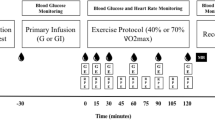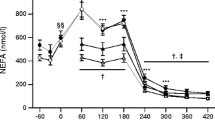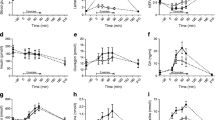Summary
The effects of restoration of glucose homeostasis on hormone-fuel metabolism of diabetic individuals during exercise (40% maximal O2 consumption) were determined by monitoring fuel oxidation rates and levels of substrates and hormones in nine normal subjects and five insulin-dependent diabetic patients while on conventional insulin therapy and after 3 days on artificial B-cell directed glucose regulation. The non-protein respiratory quotient (npRQ) and carbohydrate oxidation rate of the conventionally-treated diabetic subjects (0.908±0.002 and 538±5 mg/m2·min) were lower and the lipid oxidation rate (101±2 mg/m2·min) was significantly higher than those of the normal group during the bicycle exercise (0.937±0.004, 582±8, and 70±4 mg/m2·min, respectively). After 3 days of artificial B-cell insulin therapy, the npRQ and carbohydrate oxidation rate of the exercising diabetics significantly increased to 0.965±0.004 and 693±13 mg/m2·min, while the lipid oxidation rate declined to 39±4 mg/m2·min (p<0.001). We conclude that artificial B-cell directed insulin therapy increases carbohydrate oxidation and decreases lipid oxidation in exercising insulin-dependent diabetic subjects. However, if restoration of metabolic response identical to that of exercising normals is desired, the excess in carbohydrate oxidation coincident with elevated blood lactate and pyruvate levels suggest that the artificial B-cell therapy may not have been completely optimal, probably due to the hyperinsulinization of the diabetic patients.
Similar content being viewed by others
References
Ahlborg G., Felio P., Hagenfeldt L., Hendler R., Wahren J.: Substrate turnover during prolonged exercise in man: splanchnic and leg metabolism of glucose, free fatty acids and amino acids — J. clin. Invest.53, 1080, 1974.
Albisser A. M., Leibel B. S., Ewart T. G., Davidovac Z., Botz C. K., Zingg W., Schipper H., Gander R.: Clinical control of diabetes by artificial pancreas — Diabetes23, 397, 1974.
Berger M., Berchtold P., Cüppers H. J., Drost H., Kley H. K., Müller W. A., Wiegelmann W., Zimmermann-Telschow H., Gries F. A., Krüskemper H. L., Zimmermann H.: Metabolic and hormonal effects of muscular exercise in juvenile type diabetics — Diabetologia13, 355, 1977.
Calbiochem Doc. no LR 2021 (1977). Suggested guide for the radioimmunoassay of human C-peptide.
Costill D. L., Coyle E., Dalsky D., Evans W., Fink W., Hoopes D.: Effects of elevated plasma FFA and insulin on muscle glycogen usage during exercise — J. appl. Physiol.43, 695, 1977.
Felig P., Wahren J.: Fuel homeostasis in exercise — New Engl. J. Med.293, 1078, 1975.
Foss M. C., Vlachokosta F. V., Cunningham L. N., Aoki T. T.: Restoration of glucose homeostasis in insulin-dependent diabetic subjects. An inducible process — Diabetes31, 46, 1982.
Huggett A. S. G., Nixon D. A.: Use of glucose oxidase, peroxidase and 0-dianisidine in determination of blood and urinary glucose — Lancetii, 368, 1957.
Hultman E.: Studies on muscle metabolism of glycogen and active phosphate in man with special reference to exercise and diet — Scand. J. clin. Lab. Invest.19 (Suppl. 94), 1, 1967.
Issekutz B. Jr., Rodahl K.: Respiratory quotient during exercise — J. appl. Physiol.16, 606, 1961.
Joslin E. P., Root H. F., White P., Marble A. (Ed.): The treatment of diabetes mellitus, 10th ed. Lea and Febiger, Philadelphia, 1959; p. 243.
Lawrence R. D.: The effect of exercise on insulin action in diabetes — Brit. med. J.1, 648, 1926.
Lusk G.: Animal calorimetry. Analysis of the oxidation of mixtures of carbohydrate and fat — J. biol. Chem.59, 41, 1924.
Marble A., Smith R. M.: Exercise in diabetes mellitus — Arch. intern. Med.58, 577, 1936.
Mellanby J., Williamson D. H.: Acetoacetate. In:Bergmeyer H. (Ed.): Methods of Enzymatic Analysis, 2nd edition. Academic Press, New York, 1974; p. 1840.
Nakagawa S., Nakayama H., Sasaki T., Yoshino K., Yu Y. Y., Shinozaki K., Aoki S., Mashimo K.: A simple method for the determination of serum free insulin levels in insulin-treated patients — Diabetes22, 590, 1973.
Novak M.: Colorimetric ultramicro method for the determination of free fatty acids — J. Lipid Res.6, 431, 1965.
Passonneau J. V.: L(+)-lactate. In: Bergmeyer H. (Ed.): Methods of Enzymatic Analysis, 2nd edition. Academic Press, New York, 1974; p. 1468.
Passonneau J. V., Lowry O. H.: Pyruvate: Fluorimetric assay. In:Bergmeyer H. (Ed.): Methods of Enzymatic Analysis, 2nd ed. Academic Press, New York, 1974; p. 1452.
Peters J. P., Van Slyke D. D.: Total metabolism. In: Quantitative Clinical Chemistry, 2nd ed. Williams and Wilkins, Baltimore, 1946; p. 1.
Pfeiffer E. P., Thum Ch., Clemens A. H.: The artificial beta-cell. A continuous control of blood sugar by external regulation of insulin infusion (glucose controlled insulin infusion system) — Hormone metab. Res.6, 339, 1974.
Unger R. H., Aguilar-Parada E., Müller W. A., Eisentraut A. M.: Studies of pancreatic alpha-cell function in normal and diabetic subjects — J. clin. Invest.49, 837, 1970.
Wahren J., Felig P., Ahlborg G., Jorfeldt L.: Glucose metabolism during leg exercise in man — J. clin. Invest.50, 2715, 1971.
Wahren J., Felig P., Hagenfeldt L.: Physical exercise and fuel homeostasis in diabetes mellitus — Diabetologia14, 213, 1978.
Wahren J., Hangefeldt L., Felig P.: Splanchnic and leg exchange of glucose, amino acids, and free fatty acids during exercise in diabetes mellitus — J. clin. Invest.55, 1303, 1975.
Wieland O.: Glycerol: UV-Method. In:Bergmeyer H. (Ed.): Methods of Enzymatic Analysis, 2nd ed. Academic Press, New York, 1974; p. 1404.
Williamson D. H., Mellanby J.: D(−)-3-hydroxybutyrate. In:Bergmeyer H. (Ed.): Methods of Enzymatic Analysis, 2nd ed. Academic Press, New York, 1974; p. 1836.
Author information
Authors and Affiliations
Additional information
Research supported by NIH grants AM 15191 and AM 20530, Howard Hughes Medical Institute (U.S.A.), and FAPESP (Brazil) (no 78/1131)
Rights and permissions
About this article
Cite this article
Foss, M.C., Cunningham, L.N. & Aoki, T.T. Hormone-fuel metabolism during exercise of insulin-dependent diabetic patients treated with an artificial B-cell unit. Acta diabet. lat 26, 185–194 (1989). https://doi.org/10.1007/BF02581384
Received:
Issue Date:
DOI: https://doi.org/10.1007/BF02581384




